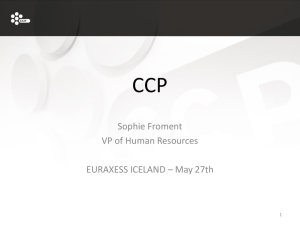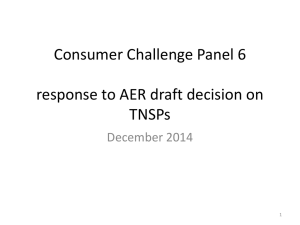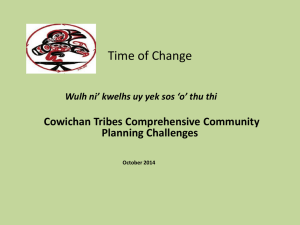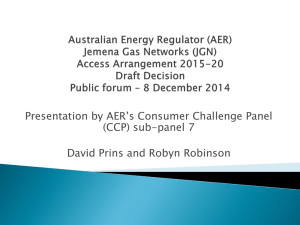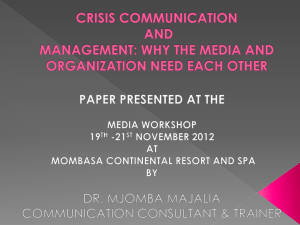- Australian Energy Regulator
advertisement
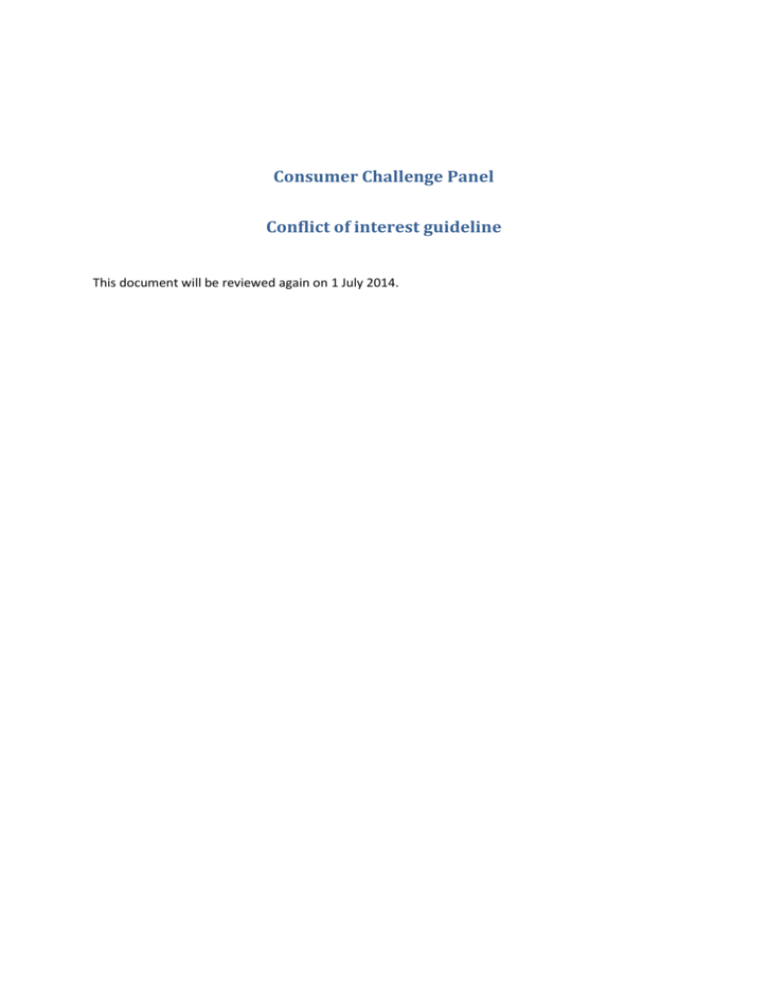
Consumer Challenge Panel Conflict of interest guideline This document will be reviewed again on 1 July 2014. Purpose The purpose of this document is to provide guidance to Consumer Challenge Panel (CCP) members around dealing with conflicts of interest. The document: 1. presents high level principles for identifying potential conflicts 2. provides guidance on managing conflicts of interest 3. includes case studies to provide practical guidance on how the principles apply and should be managed. Conflict of interest issues A conflict of interest occurs when an individual or organisation has multiple interests or is perceived to have multiple interests, one of which is potentially contrary to the motivation to act for another. In other words, conflict of interest is a set of circumstances that creates a risk that professional judgment or actions regarding a primary interest will be, or could be perceived to be, unduly influenced by another interest. Importantly, the existence of a conflict of interest does not mean that some sort of improper conduct has occurred. A conflict of interest can be disclosed and managed to ensure no impropriety. The focus of this guideline is the specific types of conflicts of ‘outside employment’ or ‘outside engagement’. That is, where a CCP member is also engaged to act for a third party which may be in conflict with their work for the CCP. Conflicts of interests can occur in relation to financial interests, political interests and others. CCP members will address these in their standing declaration of conflicts of interest. Similar principles as those set out in this guideline apply to the standing declaration. Members of the CCP have been selected because of their experience, and contributions made on behalf of consumers, and in particular, to the energy industry and wider community. In addition to working with the Australian Energy Regulator (AER), CCP members continue to make an active contribution to the Australian energy industry and wider community. Given their dual roles, conflicts, for CCP members may be difficult to avoid altogether. Our aim is to strike a balance: preventing all conflicts is not necessarily a desirable outcome as it may prevent or restrict CCP members from having active involvement in our processes or from continuing their activities in the energy industry which led to their appointment as CCP member. Therefore, the focus of this guideline is around managing conflicts of interests. The key to managing conflicts of interest will be transparency. To achieve this, we have set up a framework for disclosing and managing conflicts of interest which are supported by principles for determining whether a conflict of interest exists and how to manage those conflicts. This guideline also refers to the AER’s register of conflicts of interest (‘the register’). The purpose of the register is to provide a record of all conflicts of interest and, as appropriate, describe how those conflicts will be managed. We will maintain the register. 2 Consumer Challenge Panel: Conflict of interest guideline The Principles In considering conflict of interest issues and drafting this guideline, we have had regard to the following principles. Principle 1: Actual conflict—CCP members cannot be the ‘servant of two masters’. Principle 2: Management—where appropriate, conflicts of interest may be able to be managed. Principle 3: Transparency—potential conflicts of interest should be reported. Principle 4: Perceived conflict—CCP members need to disclose perceived conflicts of interest and develop a management strategy with the AER. Principle 5: Accountability—CCP members will be personally accountable for disclosing potential conflicts to the AER. Framework for identifying, disclosing and managing conflicts of interest We understand that members of the CCP continue to make an active contribution to the Australian energy industry and wider community. This may mean that CCP members are engaged, from time to time, by other industry participants. This is one of the strengths of the CCP. Accordingly, it will not be possible to avoid all conflicts of interests. Seeking to avoid conflicts in all situations would likely lead to an undesirable outcome where it would be challenging for the CCP to function. Therefore, to strike a balance between possible conflicts of interest and the functions of the CCP, disclosing and managing conflicts will, at times, be a more appropriate approach. Conflicts of interest may arise where: a CCP member is asked to make a contribution, or has previously made a contribution, to a third party; and the CCP member is advising the AER in relation to the relevant project. A ‘relevant project’ means a specific project which a CCP sub-panel has been formed to advise the AER on. To assist CCP members to address these conflict of interest issues, we have put together a framework to identify and manage conflicts of interest. The framework builds on the objective and key roles of the CCP as set out below. The objective of the CCP is to assist the AER to make better regulatory determinations by CCP members advising it on issues that are important to consumers. The key roles of the CCP are: advising the AER on whether the network businesses’ proposals are justified in terms of the services to be delivered to customers; whether those services are acceptable to, and valued 3 Consumer Challenge Panel: Conflict of interest guideline by, customers; and whether the network businesses’ proposals are in the long term interests of consumers; and advising the AER on the effectiveness of network businesses’ engagement activities with their customers and how this engagement has informed, and been reflected in, the development of their proposals. For further information on the objective and roles of the CCP, refer to: AER’s Consumer Challenge Panel: description, Charter and evaluation criteria, available at http://www.aer.gov.au/sites/default/files/AER%27s%20Consumer%20Challenge%20Panel%20%20Description%2C%20Charter%20and%20Evaluation%20Criteria%20%2010%20April%202013.docx Consistent with the objective and the roles of CCP, CCP members should take the following steps when determining how to address a conflict of interest. Step 1: Is there a potential conflict of interest? Determining whether a potential conflict of interest exists is a low threshold. However, several elements must be present for there to be a potential conflict: i. a third party – a third party would include any entity which participates in the AER’s regulatory processes, including regulated businesses, consultancies, advocacy bodies, lobby groups. ii. the CCP member is asked to make, or has previously made, an active contribution to the third party’s processes – ‘processes’ are considered further in step 3. iii. the CCP member is advising the AER in relation to a relevant project. If any of these elements are not satisfied then there is unlikely to be a conflict of interest. Step 2: Disclosure to the AER If the above elements exist then there is a potential conflict, and the CCP member will need to disclose the conflict to the AER by completing the conflict of interest template and discussing with the AER as appropriate. The conflict will then be recorded on the AER’s register of conflicts of interest. CCP members may need to notify changes to their standing declaration in relation to conflicts of interest interests as they occur. The CCP member will need to consult with the AER on how best to manage the conflict. Step 3: How significant is the conflict? If there is a conflict, the appropriate approach to managing the conflict will be determined by the significance of the conflict. The significance of the conflict will be informed by a consideration of three factors: i. a relevant project. 4 Consumer Challenge Panel: Conflict of interest guideline ii. the involvement of the CCP member on the CCP sub-panel—the CCP member must be a member of a CCP sub-panel which has been formed to advise the AER on a relevant project. If the CCP member has disclosed a potential conflict of interest but is not on a sub-panel considering a relevant project, then it is unlikely to be a significant conflict. The conflict should already be recorded on the register and no further management is required. iii. the nature of the contribution being made by the CCP sub-panel member to the third party. If the CCP member is on a CCP sub-panel which has been formed to advise the AER on a relevant project, then the AER, in consultation with the CCP member, will consider: Is the contribution to the third party being made in relation to a relevant project and is it the type of contribution that would likely be a direct conflict with the objective and roles of the CCP? Generally, answers to this question will fall into the following categories: a) the contribution to the third party is not a direct conflict to the CCP’s objective and roles b) some part of the contribution to the third party is a direct conflict to the CCP’s objective and roles c) the sole purpose of the contribution is in direct conflict to the CCP’s objective and roles. Step 4: How should the conflict be addressed? Depending on which category a conflict of interest falls under, determines how the potential conflict may be addressed. The AER will likely manage conflicts in these categories as set out below. a) The contribution to the third party is not a direct conflict to the CCP’s objective and roles If the contribution is not likely to lead to a direct conflict with the work of the CCP, then the most serious risk is a perception of conflict rather than an actual conflict. While an important issue, this type of conflict is of less significance. Appropriate management should mean that this conflict does not prevent the CCP member from participating in the third party’s processes or the work of the CCP sub-panel. This perception of conflict can be managed by transparency and accountability. Accordingly, these conflicts should be recorded on the AER’s register of conflicts of interest. The CCP member should be vigilant to update this register to record any changes to this conflict. b) Some part of the contribution to the third party is a direct conflict to the CCP’s objective and roles In certain situations it may be that only some part of the contribution to the third party is a direct conflict to the CCP’s objective and roles. This is quite possible where the contribution to the third party is a part of some wider piece of work. If some part of the contribution is likely to conflict with the work of the AER, then this is more likely to be an actual conflict and more active management will be required. The more active management strategy will then depend on the specific situation. Where it is possible to manage the conflict, the AER will consult with the CCP member to plan a management strategy. 5 Consumer Challenge Panel: Conflict of interest guideline For example, the AER may determine it is possible for the CCP member to contribute to the third party’s work in areas which do not conflict with the AER’s interests. In this situation, though, if the CCP member still wished to make a contribution to a third party in specific areas where there is a conflict with the AER’s work, then they would be prevented from being a CCP sub-panel member on matters that relate to that third party. This conflict and the agreed process for managing the conflict must be recorded on the AER’s register of conflicts of interest. The CCP member should be vigilant to update this register to record any changes to this conflict. Where the AER designs a management strategy, CCP members will have responsibility, and be accountable, for implementing that strategy. c) The sole purpose of the contribution to the third party is a direct conflict to the CCP’s objective and roles The situation where the sole purpose of the contribution to a third party is a direct conflict with the CCP’s objective and roles is the most significant conflict. This is an actual conflict and options for management of the conflict are limited. The CCP member would need to either remove themselves from the CCP sub-panel, or alternatively, remove themselves from the third party’s processes. In simple terms, CCP sub-panel members should not provide advice in support of any third party’s involvement in a price determination to be considered by the AER. In summary, the AER considers that potential conflict of interest situations can be classified and addressed in the following ways: No direct conflict—CCP members would be required to develop a management strategy with the AER. Potential conflict which can be managed—CCP members would be required to develop a management strategy with the AER. Potential conflict which cannot be managed—CCP members would be conflicted and should not make contributions to both the third party and the AER. CCP meetings The AER notes that CCP members may meet from time to time, either as a group, or within their subpanels. The CCP secretariat will review the register prior to any such meetings with a view to ensuring that all relevant conflicts are disclosed and the agenda for the meeting is managed appropriately. For example, if a CCP member has a conflict in relation to a particular issue, the agenda will reflect that and the CCP member will be asked to excuse him or herself from the meeting while the issue is being discussed. 6 Consumer Challenge Panel: Conflict of interest guideline Case Examples The following examples have been drawn from actual cases which have been put to the AER. Case example 1: An NSP sends around an email to CCP members inviting them to ‘participate’ and ‘provide feedback’ for the purpose of the 2014/19 revenue proposal. Determining, assessing and managing conflicts of interest The sole purpose of participating in this forum is to provide input into the engagement process which will feed into the NSP’s 2014/19 revenue proposal. Step 1: Is there a potential conflict of interest? i. An NSP is a third party involved in an AER regulatory process. ii. CCP members would be expected to participate and provide feedback so this would be ‘active contribution’. iii. All CCP members are expected to advise the AER in relation to a relevant project. CCP members would have a potential conflict of interest. Step 2: Disclosure to the AER This potential conflict of interest should be disclosed to the AER by completing the template and recorded on the register. Step 3: How significant is the conflict? The revenue determination would be a relevant project. CCP members who sit on the sub-panel for this particular AER revenue determination may have a significant conflict of interest. CCP sub-panel members would be making an active contribution which will then be used for the NSP’s revenue proposal. Given that the advice might contribute to maximising NSP revenue, then this would be considered to be in direct conflict with the CCP sub-panel members’ role. The AER would consider that this would fall into ‘Category c) the sole purpose of the contribution is in direct conflict to the CCP’s objective and roles’. Step 4: This would then be a ‘potential conflict that cannot be managed’. CCP members would be conflicted from sitting on the sub-panel and could not make contributions to the NSP and the AER. It would not be possible to manage this conflict. CCP member action The CCP member would need to either remove themselves from the CCP sub-panel, or alternatively, remove themselves from the third party’s processes. 7 Consumer Challenge Panel: Conflict of interest guideline Case example 2: CCP members attend a TNSP’s annual planning report forum Determining, assessing and managing conflicts of interest CCP members are not being asked to make an active contribution to any process that they may subsequently be asked to advise the AER on. Step 1: Is there a potential conflict of interest? i. A TNSP is a third party involved in an AER regulatory process ii. CCP members would NOT be expected to participate and provide feedback so this would NOT be ‘active contribution’. There is no potential conflict of interest for CCP members because there is no expectation that the CCP member will participate. We would encourage CCP members to be informed about the energy industry. CCP member action No action would be required. Noting the principles around transparency, accountability and perceptions of conflicts, CCP members should report their attendance at this forum on the AER’s register of conflicts of interest. 8 Consumer Challenge Panel: Conflict of interest guideline Case example 3: A CCP member works for a consulting firm that advises third parties involved in AER regulatory process Determining, assessing and managing conflicts of interest This example would very much depend on the specific issues involved, including whether the CCP member is working on a relevant project. Step 1: i. ii. iii. Is there a potential conflict of interest? A consulting firm is advising third parties involved in an AER regulatory process. CCP members would be ‘advising’ so this would be ‘active contribution’. All CCP members are expected to advise the AER in relation to a relevant project. CCP members would have a potential conflict of interest. Step 2: Disclosure to the AER This potential conflict of interest should be disclosed to the AER by completing the template and recorded on the register. Step 3: How significant is the conflict? Conflict of interest issues include: i. whether the advice provided by the CCP member to the consulting firm’s client is in relation to a relevant project. ii. is the CCP member on a sub-panel considering that relevant project. iii. if the advice is solely in relation to a relevant project, i.e. can the advice be provided separately? It would then fall into either: ‘Category a) the contribution to the third party is not a direct conflict to the CCP’s objective and roles’ ‘Category c) the sole purpose of the contribution is a direct conflict to the CCP’s objective and roles’. Step 4: How should the conflict be addressed? Where CCP members work for a consulting firm on a project advising a client on matters which are not relevant projects, there is a potential conflict that can be managed. Most likely, reporting in the AER’s register of conflicts of interest would be adequate. Where CCP members work for a consulting firm on a project advising a client on relevant projects, this would most likely be a ‘potential conflict that cannot be managed’. CCP members would be conflicted and should not make contributions to both the third party client and the AER. They could provide advice to one and not the other. It would not be possible to manage this conflict. CCP member action The CCP member should choose between sitting on the CCP sub-panel or working for the consulting firm on the project advising the third party. 9 Consumer Challenge Panel: Conflict of interest guideline Case example 4: CCP member working for an advocacy group involved in an AER regulatory process Determining, assessing and managing conflicts of interest This example would depend on the nature of the conflicts of interest and whether the CCP member is advising the AER in relation to the relevant project. Step 1: Is there a potential conflict of interest? i. The advocacy group is a third party involved in an AER regulatory process. ii. CCP member would be ‘working for the advocacy group’ so this would be ‘active contribution’. iii. All CCP members are expected to advise the AER in relation to a relevant project. CCP members would have a potential conflict of interest. Step 2: Disclosure to the AER This potential conflict of interest should be disclosed to the AER by completing the template and recorded on the register. Step 3: How significant is the conflict? Conflict of interest issues include: - the CCP member may be asked to provide advice on a relevant project - is the CCP member on a sub-panel considering that relevant project - at least some of the advice relates to matters in conflict with the objective of the NERs - if the advice is in relation to a relevant project can it be provided separately? It would then likely fall into: ‘Category a) the contribution to the third party is not a direct conflict to the price determination to be considered by the AER and the CCP sub-panel ‘Category b) some part of the contribution to the third party is a direct conflict to the price determination to be considered by the AER and the CCP sub-panel Step 4: How should the conflict be addressed? Where the CCP member is working for the advocacy group on matters that are not relevant projects, these will not give rise to conflict of interest issues. Where the CCP member is working for the advocacy group on matters that are relevant projects and the CCP member is on the CCP sub-panel, there is a potential conflict which can be managed. CCP member action It is possible that a CCP member working for an organisation could be quarantined from involvement in anything within that organisation relating to a relevant project. Such an arrangement would be developed with the AER. 10 Consumer Challenge Panel: Conflict of interest guideline Case example 5: CCP member is an advocacy group’s representative on an NSP’s consumer council Determining, assessing and managing conflicts of interest In this example the advice is going to be used by an NSP. The NSP’s consumer council will provide advice for the revenue proposal as well as a substantial amount of matters not related to the revenue proposal. Step 1: Is there a potential conflict of interest? i. In this case, the advice is going to be used by an NSP, in which case the NSP is the third party. ii. The CCP member would likely be expected to provide some contribution so this would be 'active contribution'. iii. All CCP members are expected to advise the AER in relation to a relevant project. CCP members would have a potential conflict of interest. Step 2: Disclosure to the AER This potential conflict of interest should be disclosed to the AER by completing the template and recorded on the register. Step 3: How significant is the conflict? i. If the advice was being provided in relation to a revenue determination this would be relevant project. ii. CCP members who are advising the AER on the relevant project may have a significant conflict of interest. iii. The CCP member would likely be making an active contribution which will then be used for the NSP’s revenue proposal. This would potentially conflict with their requirement to assess this very revenue proposal. Importantly, the CCP member is also to provide advice on a ‘substantial amount of matters not related to the revenue proposal’. It would then likely fall into: ‘Category b) some part of the contribution to the third party is a direct conflict to the objectives of the NERs Step 4: How should the conflict be addressed? In this situation, part of the contribution to the NSP’s consumer council would be in conflict, but only that which relates to the revenue proposal and the AER’s draft determination. This is a potential conflict which can be managed. If appropriately managed, the CCP member may be able to participate in both processes; however, the CCP member could not advise both the AER and the NSP in relation to the revenue proposal and draft determination. CCP member action One way to manage the conflict might be for the CCP member to excuse themself any time the NSP’s consumer council considers the AER’s determination during meetings. Such an arrangement would be developed with the AER. It should also be recorded on the AER’s register of conflicts of interest. CCP members who have ongoing relationships with NSPs (either directly or through entities they work for) should be vigilant in monitoring their conflicts of interest. 11 Consumer Challenge Panel: Conflict of interest guideline 12 Consumer Challenge Panel: Conflict of interest guideline Attachment A AER’s Consumer Challenge Panel: description, Charter and evaluation criteria which is available at http://www.aer.gov.au/sites/default/files/AER%27s%20Consumer%20Challenge%20Panel%20%20Description%2C%20Charter%20and%20Evaluation%20Criteria%20%2010%20April%202013.docx 13 Consumer Challenge Panel: Conflict of interest guideline
